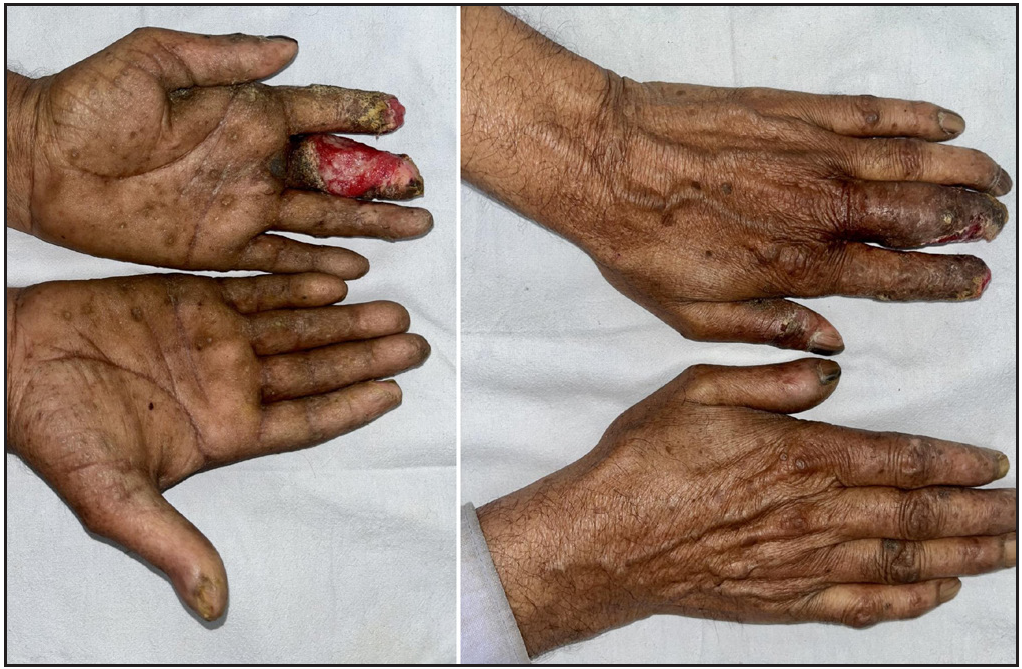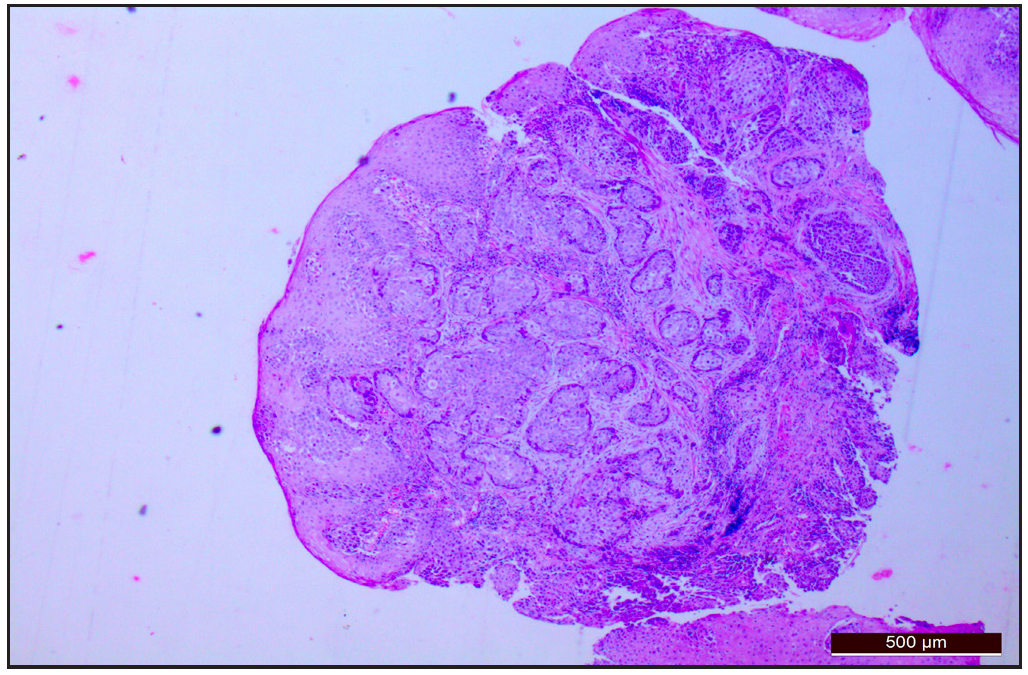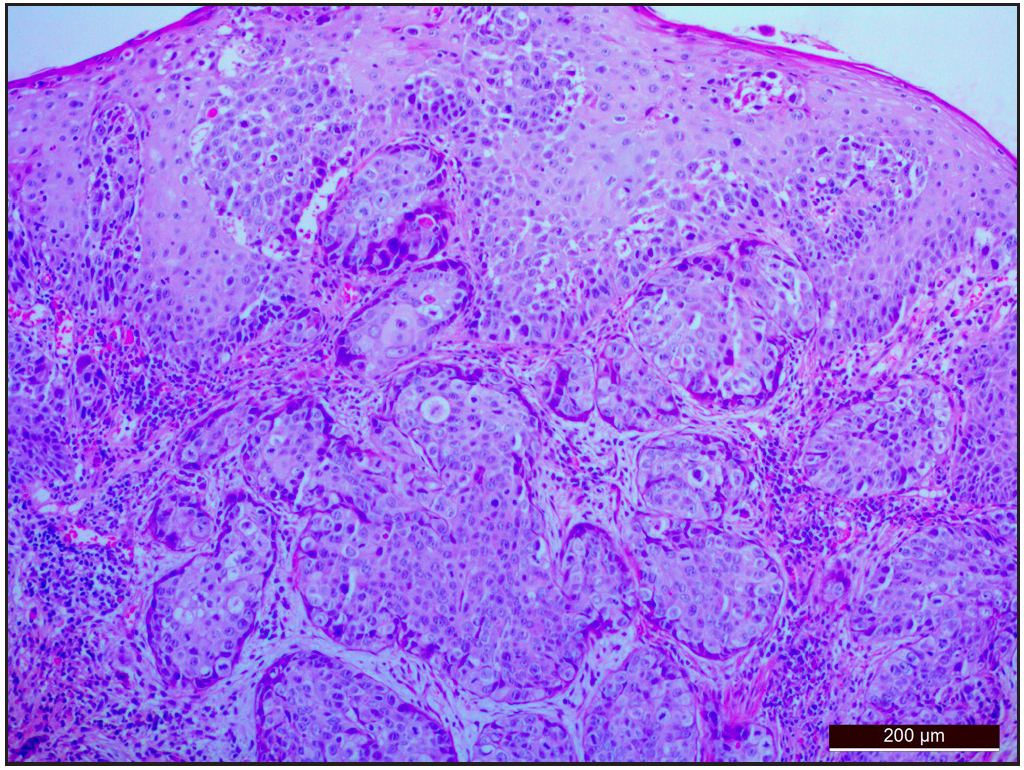Translate this page into:
Unveiling the silent threat: Exploring the cascade of radiation-induced damage culminating in cancer
Corresponding author: Dr. Keshavamurthy Vinay, Department of Dermatology, Venereology and Leprology, PGIMER, Chandigarh, India. vinay.keshavmurthy@gmail.com
-
Received: ,
Accepted: ,
How to cite this article: Sharma A, Chatterjee D, Vinay K. Unveiling the silent threat: Exploring the cascade of radiation-induced damage culminating in cancer. Indian J Dermatol Venereol Leprol. 2025;91:105-7. doi: 10.25259/IJDVL_744_2023
Dear Editor,
A 57-year-old male X-ray technician presented for evaluation of a non-healing ulcer over his left hand, which was present for the past 6 months. He had a 20-year history of palmar hyperkeratosis, progressively worsening over the past two decades. He also reported multiple small ulcerations superimposed on the hyperkeratotic areas, which healed spontaneously until recently, when he had a non-healing, ulceration on his left hand. The patient reported that he had been working with open (non-sophisticated) industrial X-rays for the initial 4 years of his work but had switched to working with sophisticated machines for the last 28 years. He also gave a history of taking precautions to limit his exposure to radiation, such as wearing protective aprons and lead-lined gloves and minimizing the duration of exposure.
Examination revealed a well-defined ulcer on the palmar aspect of his left hand’s index and middle fingers, which also partially extended to the dorsal aspect. The background skin revealed the presence of multiple hyperkeratotic papules and plaques [Figure 1]. There was no clinical or laboratory evidence to suggest arsenic toxicity in the patient. The ulcer was biopsied, and a poorly differentiated squamous cell carcinoma (SCC) diagnosis was confirmed [Figures 2 and 3]. The patient was managed with amputation of the affected finger. An evaluation for distant metastasis was negative.

- Well-defined ulcer on the palmar aspect of the left hand’s index and middle fingers, which was also partially extending to the dorsal aspect. The background skin revealed the presence of multiple hyperkeratotic papules and plaques.

- Epidermis showed marked hyperplasia, parakeratosis, and acanthosis with a focal dysplasia from which arising is a tumor arranged in sheets composed of polygonal cells with irregular hyperchromatic nuclei, moderate eosinophilic cytoplasm with focal squamous differentiation, suggestive of poorly differentiated squamous cell carcinoma (Haematoxylin and eosin; 40x).

- Epidermis showed marked hyperplasia, parakeratosis, and acanthosis with a focal dysplasia from which arising is a tumor arranged in sheets composed of polygonal cells with irregular hyperchromatic nuclei, moderate eosinophilic cytoplasm with focal squamous differentiation, suggestive of poorly differentiated squamous cell carcinoma (Haematoxylin and eosin; 100x).
The issue of radiation protection in India’s industrial and healthcare workers is pertinent given the country’s rapid industrialization and increasing reliance on nuclear power. The present case highlights the potential risk of cumulative radiation exposure in X-ray workers, leading to acral keratoses and cutaneous SCC.
In India, the Atomic Energy Regulatory Board has established guidelines for radiation protection in medical facilities, including using protective equipment such as lead aprons and lead glasses and monitoring radiation exposure levels.1 In addition to the regulatory framework, India has also established the Radiation Protection Rules2 to conduct research and develop technologies related to radiation protection. However, many industrial and healthcare workers may not take appropriate precautions to minimize radiation exposure despite these guidelines.
Industrial radiography sources emit X-rays and gamma radiation, producing dose rates of hundreds of milligrays per hour at 1 meter. The industrial X-rays could be of two types: Non-sophisticated X-rays, which use high intensity of X-rays which hence lead to a higher degree of radiation damage to the workers, whereas the sophisticated systems (including digital radiography) use lower intensity X-rays and hence are safer. These high dose rates at close distances can cause severe injuries such as radiation burns following exposures of a few seconds. Workers using such sources must achieve the protection objective to prevent acute and chronic radiation injuries. The use of lead gloves or other radiation-absorbing materials for hands, maintaining a safe distance from radiation sources, minimizing the exposure time, access to radiation monitoring devices, washing hands thoroughly after working in areas with potential radiation exposure, and regular health check-ups can help prevent any potential radioactive particles from being transferred to the body.
The Basic Safety Standards establish requirements for protection against the risks associated with industrial radiography and for safety against radiation sources that may deliver such exposure. 3
A close mimic of the said condition is arsenic poisoning, and previous studies have reported similar cases of acral keratoses and cutaneous SCC in individuals with arsenic exposure.4 Drinking water is currently the primary source of arsenic exposure worldwide and is one of the most substantial environmental carcinogens.5 Arsenical dermatoses, however, have additional findings of raindrop hypopigmentation and Mee’s lines, none of which were found in our patient. An analysis of hair and nail arsenic levels was also normal. The need for histopathological evaluation in arsenical keratosis is to rule out the presence of malignancy. Prominent compact hyperkeratosis, parakeratosis, and acanthosis are the constant features. Papillomatosis and vacuolated keratinocytes may be present. Keratinocyte atypia may or may not be seen, and its severity can vary from mild atypia to features of squamous cell carcinoma in situ.6 Major radiological consequences can be avoided if actions are initiated quickly for those accidents that have broader implications for workers, the public, and the environment. In the present case, most likely the patient had not taken strict precautions to limit his radiation exposure, especially for his hands.
X-ray technicians and other healthcare workers exposed to ionizing radiation in the workplace are at risk of developing acral keratoses and cutaneous SCC. Strict adherence to radiation protection guidelines and regular monitoring can help to detect any early signs of adverse effects and prevent the development of severe health consequences.
Declaration of patient consent
The authors certify that they have obtained all appropriate patient consent.
Financial support and sponsorship
Nil.
Conflicts of interest
There are no conflicts of interest.
Use of artificial intelligence (AI)-assisted technology for manuscript preparation
The authors confirm that there was no use of artificial intelligence (AI)-assisted technology for assisting in the writing or editing of the manuscript and no images were manipulated using the AI.
References
- Safety code for radiation therapy sources, equipment, and installations, AERB/SC/MED-2 (Rev.1). 2011.
- [Published in the Gazette of India: September 11 P-I, Subsection 3, Mumbai], 2004.
- Radiation protection and safety in industrial radiography IAEA. Safety reports series no. 13, Vienna, 1999.
- [Google Scholar]
- Acral keratoses and squamous-cell carcinomas likely associated with arsenic exposure. Dermatol Online J. 2016;22:13030/qt434929px.
- [PubMed] [Google Scholar]
- Pathogenesis, clinical features and pathology of chronic arsenicosis. Indian J Dermatol Venereol Leprol. 2008;74:559-70.
- [PubMed] [Google Scholar]






